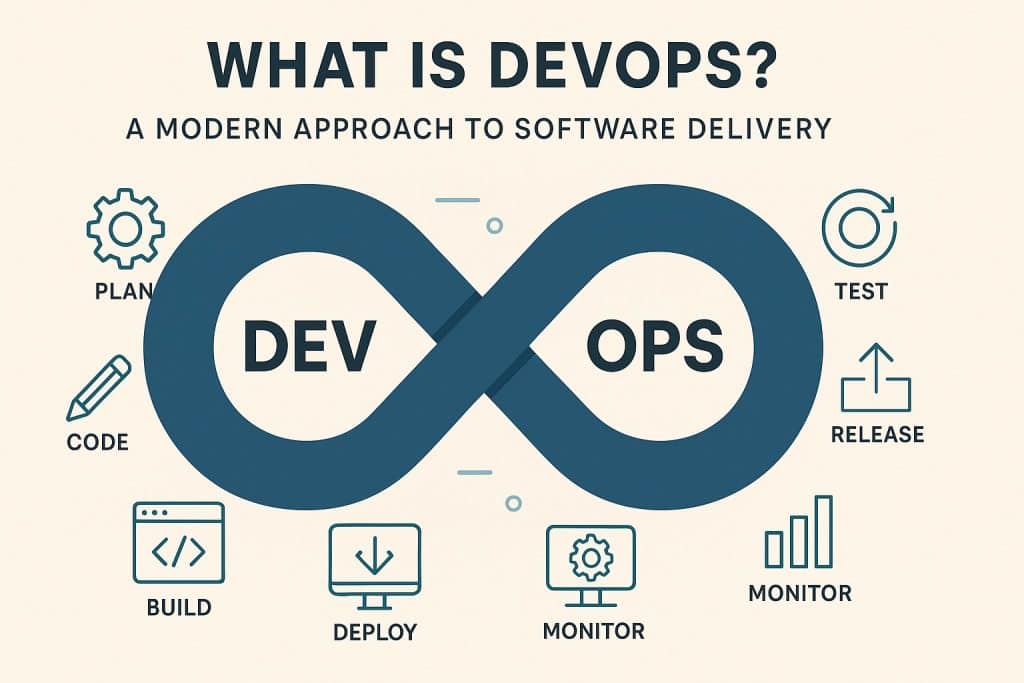
In today’s fast-paced digital world, businesses must deliver software and services faster, more efficiently, and with higher quality than ever before. Traditional software development and IT operations often worked in isolation, leading to delays, miscommunication, and costly production issues. DevOps is a revolutionary cultural and technical movement that bridges the gap between development and operations.
What is DevOps?
DevOps is a combination of development (Dev) and operations (Ops). It’s not just a set of tools or a job title. it’s a culture, and set of practices designed to improve collaboration, automate workflows, and accelerate delivery. DevOps integrates software development, IT operations, QA, and security teams into a single, agile-focused workflow with the goal of delivering value to users quickly and reliably.
Why DevOps?
Here are a few key reasons why companies across the globe are adopting DevOps:
1. Faster Time to Market
Automated pipelines, CI/CD (Continuous Integration and Continuous Deployment), and containerization allow teams to release features and updates rapidly.
2. Improved Collaboration
DevOps encourages a culture of shared responsibility. Developers understand operations. Ops understand development.
3. Enhanced Stability and Reliability
Monitoring tools, Infrastructure as Code (IaC), and automated testing reduce human error and ensure consistent environments.
4. Scalability
DevOps practices like container orchestration (e.g., Kubernetes) enable infrastructure to scale efficiently with demand.
5. Cost Efficiency
By automating manual tasks, teams can focus on innovation rather than repetitive operations, saving time and resources.
DevOps Core Principles
Understanding the guiding principles behind DevOps is essential for adopting it effectively. These pillars form the backbone of any successful DevOps implementation:
Automation:
One of the most important aspects of DevOps is automating repetitive and manual tasks, such as testing, integration, deployment, infrastructure provisioning, and monitoring. Automation not only saves time but also ensures consistency, reduces human error, and accelerates the software delivery pipeline.
Collaboration:
DevOps emphasizes a strong culture of communication and cooperation across traditionally separate teams’ development, operations, QA, and security. This shared ownership and accountability help reduce friction, speed up resolution times, and align all stakeholders toward common business goals.
Continuous Improvement:
DevOps encourages making small, incremental changes rather than large, risky releases. Frequent iterations allow teams to adapt quickly to feedback, resolve issues early, and continuously enhance the quality and performance of their applications and infrastructure.
Monitoring & Feedback:
Real-time monitoring of applications and infrastructure is key to identifying issues before they impact users. Combined with automated alerts and data-driven feedback loops, this principle helps teams make informed decisions, improve system reliability, and respond quickly to changes or incidents.
DevOps Toolchain Overview
DevOps doesn’t depend on a single tool. It’s an ecosystem that spans the software development lifecycle:
| PHASE | TOOLS |
|---|---|
| Plan | Jira, Trello, GitHub |
| Develop | Git, VSCode, GitLab |
| Build | Maven, Gradle, Docker |
| Test | Selenium, JUnit, PyTest |
| Release | Jenkins, GitHub Actions |
| Deploy | Kubernetes, Helm, Ansible |
| Operate | Prometheus, Grafana |
| Monitor | ELK Stack, Datadog |
The Future of DevOps
As technology and business needs continue to advance, so does the scope of DevOps. What began as a set of practices to bridge development and operations has grown into a dynamic, evolving ecosystem. Here are some of the key trends shaping the future of DevOps:
GitOps
GitOps is an extension of DevOps that uses Git as the single source of truth for both application and infrastructure configuration. It allows teams to manage infrastructure in the same way they manage code, with version control, pull requests, and automated pipelines. GitOps brings transparency, consistency, and control to infrastructure provisioning and application deployment, especially in cloud-native and Kubernetes environments.
AIOps
AIOps (Artificial Intelligence for IT Operations) leverages machine learning and big data to automate the detection, analysis, and resolution of issues in real time. With increasing complexity in distributed systems, AIOps helps DevOps teams proactively identify anomalies, reduce alert fatigue, and prevent outages before they impact users. It represents a shift from reactive to predictive operations.
DevSecOps
DevSecOps integrates security practices directly into the DevOps workflow, ensuring that security is a shared responsibility from the very beginning of the development lifecycle. Instead of treating security as a separate phase at the end, it’s woven into every stage, from coding and testing to deployment and monitoring. This approach reduces vulnerabilities and promotes a culture of secure software delivery.
Platform Engineering
Platform Engineering focuses on building internal developer platforms (IDPs) that abstract complex infrastructure and provide self-service capabilities. These platforms offer pre-configured environments, CI/CD pipelines, observability tools, and compliance standards, enabling developers to ship faster with greater autonomy. It enhances the developer experience while maintaining consistency.
Conclusion
DevOps is more than just a buzzword. It’s a proven approach to building, testing, and releasing software faster and more reliably. Whether you’re an aspiring engineer, developer, or IT professional, understanding DevOps is essential in today’s technology-driven landscape.
